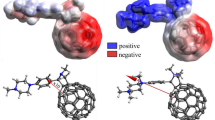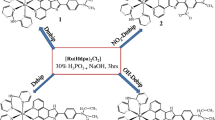Abstract
Ace naphthene as a primary material was nitrated and further reacted by various processes such as oxidation, imidation and amination in order to obtain dyad 5. The dyad 5 fluoresces in solvents of different polarity and the emission is shifted bathochromically with increasing the solvent polarity due to ICT enhancement, The fluorescent enhancement is greatest in case of chloroform (ФF = 0.48) on excitation at 420 nm,The influences of the pH on dyad 5 were also investigated, The results can be considered as representing off–on-off states. Dyad 5 executes two input XNOR logic gates, towards H+ and HO− ions, “off–on-off” switching behavior between H+ and HO− ions was observed, The synthesized compounds were tested for antimicrobial activity of Gram-positive and Gram-negative bacteria, The compounds tested have a good antibacterial activity as compared with standard compound (Gentamycin).










Similar content being viewed by others
Data Availability Statement
Authors are declare that the data supporting the findings of this study are available within the article.
Code Availability
Chemdraw, origin.
References
Magri DC, de Silva AP (2010) From PASS 1 to YES to AND logic: building parallel processing into molecular logic gates by sequential addition of receptors. New J Chem 34:476–481
Amelia M, Zou L, Credi A (2010) Signal processing with multicomponent systems based on metal complexes. Coord Chem Rev 254:2267–2280
Balzani V (2003) Photochemical molecular devices. Photochem Photobiol Sci 2:459–476
Zhu L, Lu M, Tian H (2012) Selective supramolecular bindings for stepwise signal output. Tetrahedron 68:79–84
Hamilton G, Sahoo S, Kamila S, Singh N, Kaur N, Hylanda B, Callan J (2015) Optical probes for the detection of protons, and alkali and alkaline earth metal cations. Chem Soc Rev 44:4415–4432
Aviram A (1988) Molecules for memory, logic, and amplification. J Am Chem Soc 110:5687–5692
de Silva AP, Gunaratne H, McCoy C (1993) A molecular photoionic AND gate based on fluorescent signaling. Nature 364:42–44
Bojinov V, Georgiev N (2011) Molecular sensors and molecular logic gates. J Univ Chem Technol Metall 46:3–26
de Silva AP, Uchiyama S (2011) Molecular logic gates and luminescent sensors based on photoinduced electron transfer. Top Curr Chem 300:1–28
Kaur N (2014) Supramolecular switches-advanced molecular logic and computation molecular logic gates. Curr Org Chem 18:2892–2909
Andréasson J, Pischel U (2015) Molecules with a sense of logic: a progress report. Chem Soc Rev 44:1053–1069
Pais V, Remon P, Collado D, Andréasson J, Perez-Inestrosa E, Pischel U (2011) OFF–ON–OFF fluorescence switch with T-latch function. Org Lett 13:5572–5575
Pu F, Ju E, Ren J, Qu X (2014) Multiconfigurable logic gates based on fluorescence switching in adaptive coordination polymer nanoparticles. Adv Mater 26:1111–1117
Magri DC, Camilleri Fava M, Mallia C (2014) A sodium-enabled ‘Pourbaix sensor’: a three-input AND logic gate as a ‘lab-on-a-molecule’ for monitoring Na+, PH and PE. Chem Commun 50:1009–1011
Ling J, Naren G, Kelly J, Moody T, de Silva AP (2015) Building pH sensors into paper-based small-molecular logic systems for very simple detection of edges of objects. J Am Chem Soc 137:3763–3766
de Silva AP, McClenaghan N (2004) Molecular-scale logic gates. Chem Eur J 10:574–586
Magri DC, Vance T, de Silva AP (2007) From complexation to computation: recent progress in molecular logic. Inorg Chim Acta 360:751–764
de Silva AP (2013) Molecular logic-based computation. Royal Society of Chemistry Cambridge, pp 302–315. https://doi.org/10.1039/9781849733021-00302
Jiang W, Zhang H, Liu Y (2009) Unimolecular half-adders and half-subtractors based on acid-base reaction. Front Chem China 4:292–298
Margulies D, Melman G, Shanzer A (2006) Full-adder and full-subtractor, an additional step toward a moleculator. J Am Chem Soc 128:4865–4871
Amelia M, Baroncini M, Credi A (2008) A simple unimolecular multiplexer/demultiplexer. Angew Chem 120:6336–6339
Ceroni P, Bergamini G, Balzani V (2009) Old molecules, new concepts: [Ru(bpy)3]2+ as a molecular encoder–decoder. Angew Chem Int Ed 48:8516–8518
Georgiev N, Dimov S, Asiri A, Alamry K, Obaid A, Bojinov V (2014) Synthesis, selective pH-sensing activity and logic behavior of highly water-soluble 1,8-naphthalimide and dihydroimidazonaphthalimide derivatives. J Lumin 149:325–332
Georgiev N, Lyulev M, Alamry K, El-Daly S, Taib L, Bojinov V (2014) Synthesis, sensor activity and logic behavior of a highly water-soluble 9,10-dihydro-7H-imidazo[1,2-b]benz[d, e]isoqionolin-7-one dicarboxylic acid. J Photochem Photobiol A Chem 297:31–38
Li Q, Yue Y, Guo Y, Shao S (2012) Fluoride anions triggered “OFF–ON” fluorescent sensor for hydrogen sulfate anions based on a BODIPY scaffold that works as a molecular keypad lock. Sensors Actuators B Chem 173:797–801
Macdonald J, Li Y, Sutovic M, Lederman H, Pendri K, Lu W, Andrews B, Stefanovic D, Stojanovic M (2006) Medium scale integration of molecular logic gates in an automaton. Nano Lett 6:2598–2603
Ozlem S, Akkaya E (2009) Thinking outside the silicon box: molecular AND logic as an additional layer of selectivity in singlet oxygen generation for photodynamic therapy. J Am Chem Soc 131:48–49
Valeur B, Leray I (2000) Design principles of fluorescent molecular sensors for cation recognition. Coord Chem Rev 205:3–40
de Silva AP, Vance T, West M, Wright G (2008) Bright molecules with sense, logic, numeracy and utility. Org Biomol Chem 6:2468–2481
Daly B, Ling J, de Silva A (2015) Current developments in fluorescent PET (photoinduced electron transfer) sensors and switches. Chem Soc Rev 44:4203–4211
Badugu R (2005) Fluorescence sensor design for transition metal ions: the role of the PIET interaction efficiency. J Fluoresc 15:71–83
Sareen P, Kaur D, Singh K (2014) Strategies in detection of metal ions using dyes. Coord Chem Rev 265:125–154
Georgiev N, Bojinov V, Nikolov P (2011) The design, synthesis and photophysical properties of two novel 1,8-naphthalimide fluorescent pH sensors based on PET and ICT. Dyes Pigm 88:350–357
Dash N, Malakar A, Kumar M, Mandal B, Krishnamoorthy G (2014) Metal ion dependent “ON” intramolecular charge transfer (ICT) and “OFF” normal switching of the fluorescence: sensing of Zn2+ by ICT emission in living cells. Sens Actuators B Chem 202:1154–1163
Hu J, Wu F, Feng S, Xu J, Xu Z, Chen Y, Tang T, Weng X, Zhou X (2014) A convenient ratiomeric pH probe and its application for monitoring pH change in living cells. Sens Actuators B Chem 196:194–202
Qian J, Qian X, Xu Y, Zhang S (2008) Multiple molecular logic functions and molecular calculations facilitated by surfactant’s versatility. Chem Commun 35:4141–4143
Georgiev N, Yaneva I, Surleva A, Asiri A, Bojinov V (2013) Synthesis, sensor activity and logic behavior of a highly water-soluble naphthalimide derivative. Sens Actuators B Chem 184:54–63
Zammit R, Pappova M, Zammit E, Gabarretta J, Magri DC (2015) 1,3,5-Triarylpyrazolines—pH-driven off-on-off molecular logic devices based on a “receptor1–fluorophore–spacer–receptor2” format with internal charge transfer (ICT) and photoinduced electron transfer (PET) mechanisms. Can J Chem 93:199–206
Georgiev N, Dimitrova M, Asiri A, Alamry K, Bojinov V (2015) Synthesis, sensor activity and logic behaviour of a novel bichromophoric system based on rhodamine 6G and 1,8-naphthalimide. Dyes Pigm 115:172–180
Mahjan V, Shinde A, Popat DB, Hanumant B, Wakhrakar RD (2005) Convenient Synthesis of 5-Methylene-4-Substituted-2(5H)-Furanones. Tetrahedron Lett 46:1009–1012. https://doi.org/10.1016/j.tetlet.2004.12.040
Husain A, Khan M, Hasan SM, Alam MM (2005) 2-Arylidene-4-(4-Phenoxy-Phenyl)but3-en-4-Olides: Synthesis, Reactions and Biological Activity. Eur J Med Chem 40:1394–1404. https://doi.org/10.1016/j.ejmech.2005.03.012
Georgiev N, Sakr A, Bojinov V (2015) Design and synthesis of a novel PET and ICT based 1,8-naphthalimide FRET bichromophore as a four-input Disabled–Enabled-OR logic gate. Sens Actuators B Chem 221:625–634
Pasaogullari N, Icil H, Demuth M (2006) Dyes Pigm 69:118
Acknowledgements
Authors acknowledge gratefully the financial support provided from Erasmus mundus association.
Funding
Funding provided by Erasmus mundus scholarship (medastar program).
Author information
Authors and Affiliations
Contributions
Alaa R. Sakr: investigation (writing, synthesis, photochemistry and spectral analysis); Nikolai I. Georgiev: methodology, investigation; Vladimir B. Bojinov: supervision,writing, review and editing.
Corresponding author
Ethics declarations
Ethical Approval
Not applicable.
Consent to Participate
Not applicable.
Consent for Publication
Not applicable.
Competing Interests
The authors declare no competing interests.
Additional information
Publisher's Note
Springer Nature remains neutral with regard to jurisdictional claims in published maps and institutional affiliations.
Supplementary Information
Below is the link to the electronic supplementary material.
Rights and permissions
Springer Nature or its licensor holds exclusive rights to this article under a publishing agreement with the author(s) or other rightsholder(s); author self-archiving of the accepted manuscript version of this article is solely governed by the terms of such publishing agreement and applicable law.
About this article
Cite this article
Sakr, A., Georgiev, N. & Bojinov, V. Design, Photochemistry, Logic Gates Behavior and Antibacterial Evaluation of ICT Systems based on 1,8-naphthalimides. J Fluoresc 33, 43–51 (2023). https://doi.org/10.1007/s10895-022-03035-9
Received:
Accepted:
Published:
Issue Date:
DOI: https://doi.org/10.1007/s10895-022-03035-9




